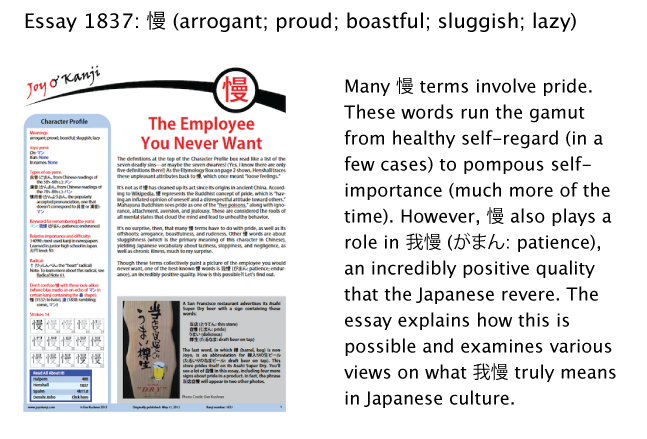Head to Toe
Let's start with a quiz. What do you think the following term could mean?
頭を刈る (あたまをかる) head + to cut
a. to cut off someone's head
b. to cut the head off a fish
c. to cut one's hair
d. to excel; be a cut above the rest; stand heads and tails above others
I'll give you a moment to think about it.

Woodblock print by Koitsu Tsuchiya (1870–1949). It depicts the Sacred Bridge (神橋, しんきょう) in Nikko that commoners were not allowed to cross.

Photo Credit: Eve Kushner
The same bridge in 2010.
Here's the answer:
c. 頭を刈る (あたまをかる: head + to trim (hair)) means "to cut one's hair." I changed the second part of the breakdown so that it's closer to this meaning, but that doesn't resolve the fundamental problem. Why is 頭 in this expression at all?! I was sure, when I saw 頭を刈る, that it referred to slicing off someone's head, samurai-style. (For that you need 首を刈る, where 首 (くび) means "neck.")
Lately, I've been knee-deep in 頭 terms, such as this word from essay 1823 on 没 (sinking; immersion; to die; disappearing; lack), which is forthcoming:
没頭 (ぼっとう: immersion) to sink, become absorbed in + head
With this term, someone is up to his or her head in a task or subject matter!
By writing essay 1837 on 慢 (arrogant; proud; boastful; sluggish; lazy), which just came out today, I learned another great 頭 term:
頭に来る (あたまにくる: to get mad) head + to come
I have no idea what's going on with the etymology here, though it may refer to what happens when our blood figuratively boils; at such times, blood literally rushes up into the face and the rest of the head. Anyway, 頭に来る is a common colloquial way of saying “to get mad." A sample sentence:
彼の傲慢さには本当に頭に来るよ。
His arrogance really pisses me off.
彼 (かれ: he); 傲慢さ (ごうまんさ: pride;
haughtiness; arrogance); 本当に (ほんとうに: really)
Because I've known the basic meanings and readings of 頭 for years, I didn't think there was much more to it, but that's never the case with kanji. Simply by perusing Halpern's abridged dictionary I found several surprises:
毛頭 (もうとう: (not) in the least, (not) a bit)
Now we finally see 毛 (hair), but why is there a hair in this word? As an adverb, says my proofreader, this term originally meant "the tip (頭) of a hair (毛)." So the negative form 毛頭ない literally means "not even as little as the tip of a hair."
I seem to have lost my head—my focus on 頭, that is. I need to keep this topic in mind. That is, I must do this:
頭に入れる (あたまにいれる: to keep in mind) head + to insert
All right, then. Here's another great 頭 term:
羊頭狗肉 (ようとうくにく: using a better name to sell inferior goods; crying wine and selling vinegar) sheep + head + dog + meat
I love the second definition! The third kanji is non-Joyo and is the primary way of writing "dog" in Chinese."
Are we supposed to think that it's more appetizing to eat the head of a sheep or the meat of a dog? I'll pass on both, thanks.
I'll stick to fish, though there's recently been news about how the very kind of deception represented by 羊頭狗肉 is rampant when it comes to seafood sales, causing lots of "fish fraud." Though I could have linked to any number of articles about this, I can't resist the one cleverly titled "Bait and Switch."
Speaking of fish, here's a word of vital importance to me:
尾頭付き (おかしらつき: fish served with head and tail still attached)
tail + head + attached
I simply cannot be at the same table with a cooked fish that's staring into space with a glassy eye, its thick lips open as if it's gasping for air. In a ryokan near Nikko, when they served us a whole fish, I nervously requested that they cut off the head and tail. They did this with much amusement and considerable graciousness, even removing all the bones. It would have been better, though, if I had asked from the get-go whether the fish would arrive with all its parts. Now I have the right vocabulary, as long as I can remember to use the kun-yomi of かしら for 頭.
Here's one more 頭 term that surprised me when I wrote essay 1047 on 菓 (confection):
饅頭 (まんじゅう: steamed bun filled with red bean paste) manju + head
The first kanji in this term is non-Joyo and now means "manju" (just as 饅頭 does). So what's the connection to heads? Scholars believe that the Chinese originally wrote this term as 蛮頭 (barbarian + head), which was possible because 饅 and 蛮 are homophonic in Mandarin, though not in Japanese. Back then, the term really did refer to slicing off someone's head! Wikipedia explains the etymology of 饅頭, referring to it as mantou because that's the Mandarin pronunciation.
I've spent all this time lost in my head, so it might be grounding to think instead about the feet. When a Japanese friend wrote the following sentence in an email this week, the hiragana at the end made me scratch my head:
日本語の感覚を英語で言い表したいという私のあがきです。
My struggle is expressing Japanese nuances in English.
日本語 (にほんご: Japanese); 感覚 (かんかく: nuances; feelings);
英語 (えいご: English); 言い表す (いいあらわす: to express in words);
私 (わたし: I)
I looked up あがき and found this term:
足掻き (あがき: struggling; pawing (e.g., horses' hooves)) foot + scratch, paddle
Ah, so while I was scratching my head over my friend's Japanese, he was scratching his "hoof" in the dirt, trying to make an elegant leap over the massive hurdle that separates native speakers of each language. As I've since learned, 足掻き (or its verb form 足掻く) usually implies that the struggle is pointless. My friend was probably trying to sound humble by saying that he may never clear that hurdle, despite all his efforts.
By the way, 掻 is non-Joyo and plays a part in a phrase meaning "beheading": 首を掻く (くびをかく: "to cut off the neck"). Everything circles back to beheadings!
As long as I'm circling back, I'll mention again (so that you can 頭に入れる) that essay 1837 on 慢 has just come out today. Here's a preview:

By the way, did you notice that 慢 and the first kanji in 饅頭 (まんじゅう: steamed bun filled with red bean paste) share a right-hand component?! What a glorious puzzle we find in Chinese characters! How can anyone bear to do anything but play with these pieces all day?!
Have a great weekend!

Comments